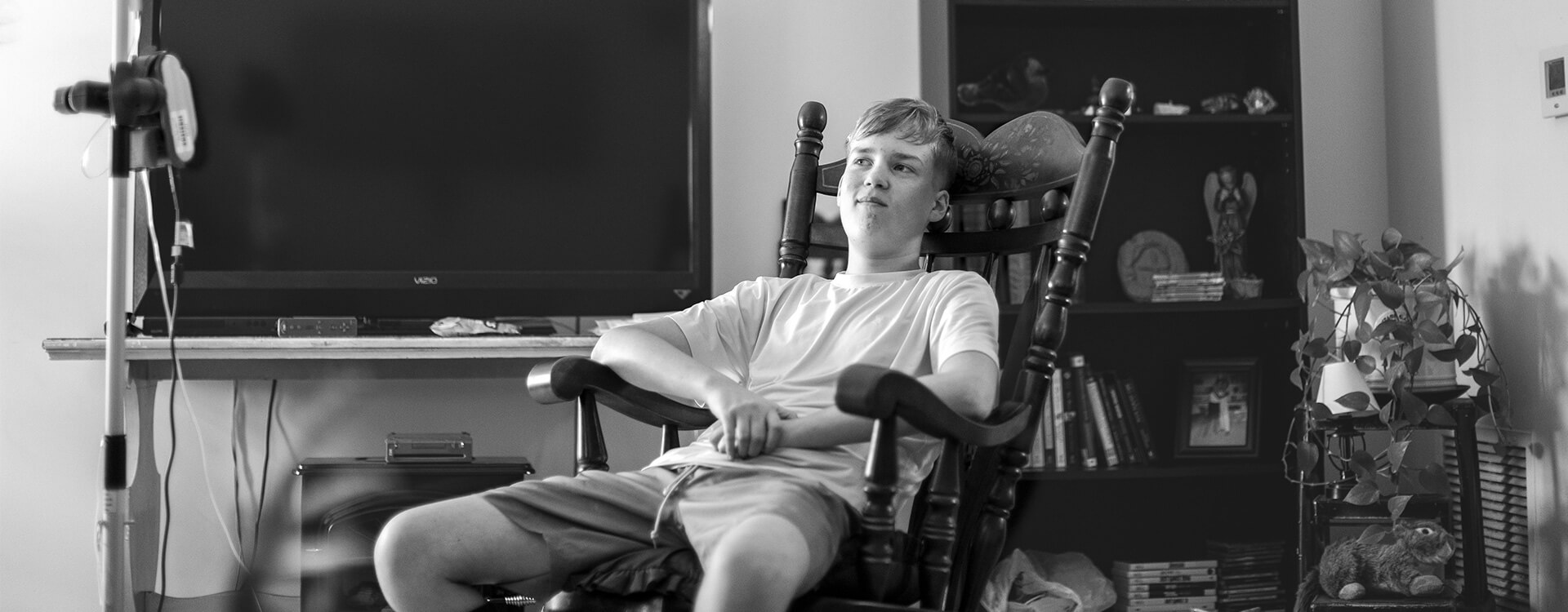Dakota
Living with Pompe disease, Durham, NC
“Dakota makes my life so much better seeing his positive outlook and upbeat personality—he’s a blessing for so many other families and ours.” —Deana (Dakota’s mom)
It’s 6 am – meet Dakota
Dakota woke up early this morning—around 6 am—to make fudge brownies. The early preparations are necessary because today is also Dakota’s infusion day.
Every infusion day, Dakota stays home, missing a day of school during the school year, to receive an infusion of the enzyme α-glucosidase, which his body does not naturally produce. This enzyme deficiency is the cornerstone of infantile Pompe disease, a glycogen storage disorder that has affected Dakota since birth. The medicine is unquestionably life-saving and receiving infusions is a crucial part of the routine for Dakota and his mother, Deana.
The whole process—mixing the solutions, prepping the port in Dakota’s chest, letting the medicine infuse, and cleaning up afterward—takes the better part of the day. For the past three years, Dakota has been getting infusions at home, allowing him some free-time and comfortable surroundings. Prior to that he spent his days in Duke University Hospital, receiving his transfusions from staff there.
He has survived longer than expected thanks in part to prenatal screening and enzyme replacement therapy (ERT). At just 10 weeks old, he had a port surgically implanted in his chest to allow for intravenous ERT. Dakota’s health is owed in large part to this early intervention. His symptoms include difficulty walking long distances and consistent discomfort in his lower extremities. Dakota’s mobility will, sadly, always be a question, and the possibility of one day using a wheelchair is an open discussion, although certainly something Dakota would prefer to avoid. “I feel happiest when I can run around and play sports,” he says. “A lot of people are very surprised at what I can do.” Despite the severity of his disease, Dakota has been able to live a relatively normal life and do what his family seems to do best, find the humor in it all.
A mother’s most difficult decision
Dakota’s growth and well-being exist alongside the shadow of loss. Mason, Dakota’s brother, was born five years before Dakota with the same recessive inheritance pattern that causes Pompe. “I knew when he was born that something wasn’t right,” recalls Deana. “He wouldn’t nurse. He was sweating. He was floppy.”
Mason would live only seven-and-a-half months before Pompe took his life. He had become completely immobile, refused to eat, and ran high fevers. “He had pneumonia and a heart murmur,” remembers Deana. A month before Mason died, they performed a muscle biopsy on him and concluded that he was born with Pompe disease. There was no treatment at the time, and Deana watched her son helplessly succumb to a disease she could do nothing about.
When Deana became pregnant again, apprehensions went swirling among family members and doctors. “They didn’t want to see me go through that again,” says Deana. At five months, doctors did an amniocentesis to ascertain if Dakota would be affected by Pompe. The results were positive and Deana was devastated. “In my mind, I was going to have to sit and watch another child pass away,” she recalls. She consulted geneticists and obstetricians. In the five years since Mason died, there had been new developments in treating Pompe, she learned, and although doctors were reticent to give Deana the green-light, she glimpsed a spark of hope. “‘I’m going to have him,’” she told doctors and family. “I decided to give him life, and that was the best decision I ever made.”
A blessing without disguise
Starting at birth, Dakota began to help his medical team break new ground in terms of understanding Pompe disease and what effect treatment could have. “Doctors have learned so much from him,” says Deana. “The day Dakota was born, I asked the cardiologist to do an echo of his heart. No physician had gotten an echo from another Pompe baby. From the moment he was born, his heart had already started to enlarge.” Dakota was able to receive regular ERT from Duke University Hospital at only 10 days old, making him the youngest at Duke to receive the therapy. Deana moved to Durham to allow Dakota easy access to his infusion site.
In contrast to Mason, Dakota met numerous milestones in his early years. His mobility was mostly unencumbered and much to Deana’s surprise, he would often escape from his crib. Now, in his early teens, Dakota continues to maintain a relatively normal, full life, a testament to the developments in managing Pompe disease. There have been necessary interventions: surgeries to both his legs (which are now braced to keep from contracting), new ports installed in his chest, and the persistent use of ERT, but Dakota is by most accounts thriving.
“If Dakota can do so well with early treatment then I can only hope that all of the new babies with infantile- and late-onset Pompe can do as great and even better than Dakota. Dakota makes my life so much better seeing his positive outlook and upbeat personality—he’s a blessing for so many other families and ours.”

